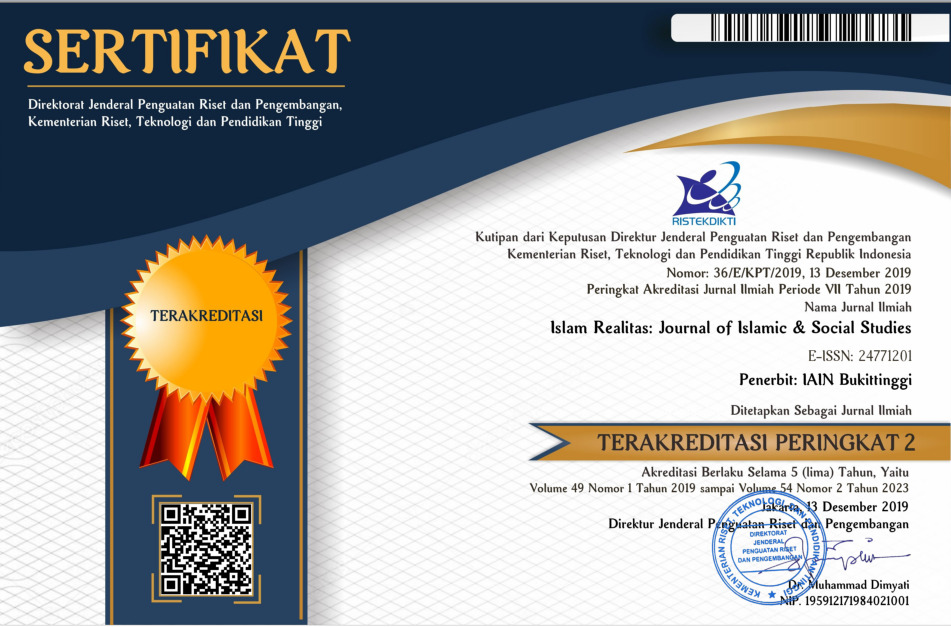THE DYNAMIC OF MALAY-MUSLIM CHINESE RELATION IN CONTEMPORARY PALEMBANG
Downloads
Additional Files
This paper aims to determine the dynamics of Muslim Chinese and Malay relation in Palembang. This qualitative research is conducted with descriptive analytics. Data are obtained by interviews, documentation, and observation. This study engages the socio-historical approach, namely studying the conflict and integration between Malays and Chinese in Palembang by looking at the history and the socio-politics. The research finds that the conflict between the two groups was strongly influenced by the political dynamics at the national level which spreads to Palembang. On the other hand, the process of integration between Chinese and Malays is unique and naturally integrated which is solved pragmatically The integration potentiality lies on the local narratives of a strong attachment between Malay and Chinese cultures.
Â
Tulisan ini bertujuan untuk mengetahui pasang surut relasi kelompok Muslim Tionghoa dan Melayu di tingkat lokal yaitu Palembang. Penelitian ini termasuk dalam penelitian kualitatif yang disajikan dengan deskriptif analitis. Data diperoleh dengan wawancara, dokumentasi dan observasi. Penelitian ini termasuk penelitian deskriptif kualitatif dengan pendekatan sosio historis, yaitu mengkaji konflik dan integrasi antara Melayu dan Tionghoa di Palembang dengan menilik pada sejarah dan kondisi sosial politik yang melatarbelakanginya Dari penelitian yang dilakukan ditemukan bahwa konflik antara kedua kelompok itu sangat dipengaruhi oleh dinamika politik di tingkat nasional (baca: yang terjadi di Jawa) yang berkembang hingga Palembang. Selanjutnya, integrasi antara Tionghoa dan Melayu memiliki keunikan tersendiri karena berjalan dengan natural didasarkan pada prinsip pragmatis. Sedangkan potensi integrasi dapat dilihat narasi-narasi keterikatan yang kuat antara Melayu dan Tionghoa yang menambah khazanah multikultural dari budaya Melayu Palembang itu sendiri.
Books
Abdullah, M., (ed.al), Kota Palembang Sebagai Kota Dagang dan Industri (Jakarta: IDSN Depdikbud, 1984)
Brown, Graham K., The Formation and Management of Political Identities: Indonesia and Malaysia Compared (New York: Centre for Research on Inequality, Human Security and Ethnicity, 2005)
Hanafiah, D., Melayu-Jawa: Citra Budaya dan Sejarah Palembang (Jakarta: RajaGrafindo Persada, 1995) <https://books.google.co.id/books?id=YEVxAAAAMAAJ>
Jumhari, Sejarah Sosial Orang Melayu Kerturunan Arab dan Cina di Palembang dari Masa Kesultanan Palembang Hingga Reformasi (Padang: BPNST Padang Press, 2010)
Sen, Tan Ta, Cheng Ho and Islam in Southeast Asia (Singapore: Institute of Southeast Asian Studies, 2009)
Sevenhoven, J. I. van, Lukisan Tentang Ibu Kota Palembang, Seri Terdjemahan Karangan-Karangan Belanda (Jakarta: KITLV Press, 2015) <https://books.google.co.id/books?id=JFkNjwEACAAJ>.
T., Shiraishi, The Rise of China and Its Implications for East Asia." In Sinicization and the Rise of China (UK: Routledge, 2013)
Zed, Mestika, Kepialangan, Politik, dan Pevolusi: Palembang, 1900-1950 (Jakarta: LP3ES, 2003)
Zen, Abdul Baqir, Etnis Cina dalam Potret Pembauran di Indonesia (Jakarta: Gema Insani, 2010)
Journals
Andaya, Barbara Watson, ‘The Cloth Trade in Jambi and Palembang Society during the Seventeenth and Eighteenth Centuries’, Indonesia, 48.48 (1989), 27 <https://doi.org/10.2307/3351265>
Azra, Azyumardi, ‘The Indies Chinese and the Sarekat Islam an Account of the Anti-Chinese Riots in Colonial Indonesia’, Studia Islamika, 1.1 (1994), 25–53 <https://doi.org/10.15408/sdi.v1i1.865>
Kamal, Muhiddinur, ‘Harmony in Diversity: Study on Potential Harmonious Multicultural Society “Pantara†Regions (Panti-Tapus-Rao) Northern Border of West Sumatra’, Islam Realitas: Journal of Islamic & Social Studies, 4.2 (2018), 148 <https://doi.org/10.30983/islam_realitas.v4i1.511>
Purnawati, ‘Tugu Prasasti Cina’, Jurnal Tamaddun, 27. 1 (2004), 12
Post, Peter, ‘The Formation of the Pribumi Business Élite in Indonesia, 1930s-1940s’, Bijdragen Tot de Taal-, Land- En Volkenkunde / Journal of the Humanities and Social Sciences of Southeast Asia, 152.4 (1996), 609–32 <https://doi.org/10.1163/22134379-90003956>
Suryadinata, Leo, ‘Kebijakan Negara Indonesia Terhadap Etnik Tionghoa: Dari Asimilasi ke Multikulturalisme?’, Antropologi Indonesia, 0.71 (2014) <https://doi.org/10.7454/ai.v0i71.3464>
Tan, Eugene K B, ‘From Sojourners to Citizens: Managing the Ethnic Chinese Minority in Indonesia and Malaysia’, Ethnic and Racial Studies, 24.6 (2001), 949–78 <https://doi.org/10.1080/01419870120077922>
Wertheim, W. F., ‘Changes in Indonesia’s Social Stratification’, Pacific Affairs, 28.1 (1955), 41 <https://doi.org/10.2307/2753710>
Other references
Kodiran, ‘Asimilasi Etnis Tionghoa Indonesia dan Implikasinya terhadap Integrasi Nasional :Studi di Kota Tanjungbalai Provinsi Sumatera Utara’ {unpublished doctoral thesis, Universitas Gadjah Mada, Yogyakarta , 2012}
Fikiran Rakyat, 25 March 1961
The Singapore Free Press, 11 August 1960
Harun (Local historian), Interview {Friday, 23 May 2018}
Authors who publish with this journal agree to the following terms:
- Authors retain copyright and grant the journal right of first publication with the work simultaneously licensed under a Creative Commons Attribution License that allows others to share the work with an acknowledgment of the work's authorship and initial publication in this journal.
- Authors are able to enter into separate, additional contractual arrangements for the non-exclusive distribution of the journal's published version of the work (e.g., post it to an institutional repository or publish it in a book), with an acknowledgment of its initial publication in this journal.
- Authors are permitted and encouraged to post their work online (e.g., in institutional repositories or on their website) prior to and during the submission process, as it can lead to productive exchanges, as well as earlier and greater citation of published work (See The Effect of Open Access).









